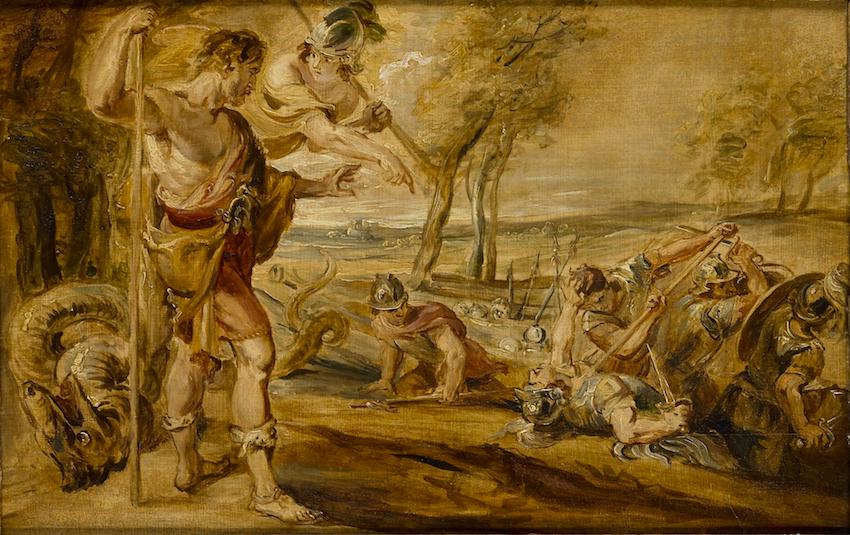The Myths of Thebes

Sowing the Dragon's Teeth. Workshop of Peter Paul Rubens - www.geheugenvannederland.nl
We return once more to the Argive genealogy and to Belos and Agenor. Agenor had moved to Phoenicia and, when his daughter Europa was carried off by Zeus, had sent his sons to look for her, ordering them never to return without her. One of these sons, Kadmos, will be the founder of Thebes.
Unlike his brothers Kadmos travelled north and west in search of Europa. His mother Telephassa accompanied him until they got to Thrace, where she died. Kadmos continued west into Greece and went to the Delphic oracle to ask about Europa. The answer was that he should forget about Europa, and instead find a certain cow (with white marks like full moons on both sides), follow it until it lay down, and start a new city there. Kadmos found the cow, followed it to Boiotia, and, when it lay down, decided to sacrifice the cow and found his city of Kadmeia. He sent some of his men to fetch water from a nearby spring, but a great serpent (who guarded the spring, which was sacred to the god Ares) killed many of them. Athena now appeared and told Kadmos to plant half of the serpent's teeth in the ground; she kept the other half to give later to king Aietes of Kolchis, who will use them to test Iason when he comes in search of the Golden Fleece.
Armed warriors called Spartoi ("Sown-Men") grew from the planted teeth and began to fight one another, in some versions because Kadmos threw stones at them and they thought the other Spartoi were doing the throwing. Only five survived (Echion, Oudaios, Chthonios, Hyperenor, and Peloros), and the aristocracy of historical Thebes traced their lineage back to these five Spartoi.
Kadmos himself was punished by having to serve Ares as a laborer for an "eternal year" (eight normal years); what he did during this time is a mystery. When he finished the eternal year, he became king of Kadmeia and received from the gods Harmonia, daughter of Ares and Aphrodite, to be his wife.
The wedding of Kadmos and Harmonia was one of the two great social events of Greek myth (the other being the wedding of Peleus and Thetis). All the gods left Olympos for the occasion, and Kadmos presented Harmonia with two magnificent gifts, a necklace and robe made by Hephaistos, the craftsman god. Music was provided by Apollo and the nine Muses, and Demeter was so captivated by Harmonia's handsome brother Iasion that she had sex with him in a thrice-plowed field.
Kadmos and Harmonia had one son, Polydoros, and four daughters, Autonoe, Semele, Ino, and Agave. The lives of the daughters were so filled with misfortune that Kadmos and Harmonia, in their old age, left Thebes and settled in Illyria. Agave, one of his daughters, was exiled from Thebes for killing her son Pentheus and went also to Illyria. Here she married king Lykotherses and then killed him so Kadmos could be king. Finally Kadmos and Harmonia were changed into serpents by Ares and sent to live in the Elysian Fields, the Greek paradise.
Kadmos was remembered by later Greeks chiefly for his introduction of the alphabet, which they called Kadmeian Letters (since the first Greek alphabet was adapted from the Semitic alphabet of the Phoenicians in the 8th century BC, and Kadmos was the most famous mythical immigrant from Phoenicia).
When Kadmos left Thebes, the kingship was assumed not by his son
Polydoros but by Pentheus, whose mother and father were Kadmos' daughter Agave
and Echion, leader of the Spartoi.
